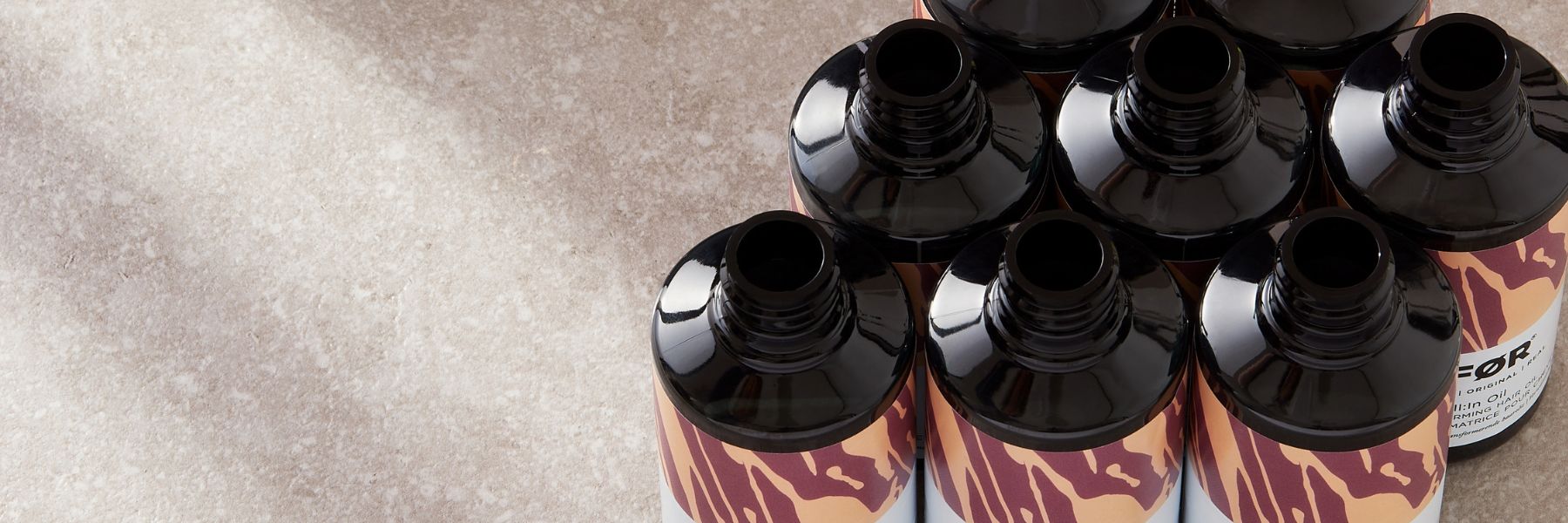PCR vs Glass - Why We Went For Plastic
12th Jan 2024

When it comes to choosing sustainable hair products and their packaging, you’d be forgiven for thinking that glass is the best option. It’s made of natural ingredients, can be reused and is usually recyclable.
However, sustainability isn’t just about what packaging is made of. There are some other things to think about when it comes to the plastic vs glass debate. Here’s why we chose recycled plastic over glass across our range of vegan haircare.
What is PCR plastic?
Post-Consumer Recycled (PCR) plastic is a type of recycled plastic material that’s made from plastic waste that’s already been used and has been passed for recycling. This could be bottles, containers and other packaging, which has been used and returned for recycling. Rather than being discarded, this plastic is reprocessed and reused in new products.
How is PCR plastic made?
The process of making PCR plastic involves collecting, sorting, cleaning and reprocessing plastic waste into pellets that can then be reformed and used to create new packaging. The collected plastic goes through quality checks and is transformed into a usable form, reducing the need for brand new plastic. There’s enough of it around, and much of it isn’t recyclable, so reusing it is by far the best option as part of a circular economy.
Benefits of PCR plastic
Let’s delve a bit deeper into the benefits of using PCR plastic FFØR’s sustainable hair care packaging. This is something we thought long and hard about when creating our product packaging. It is incredibly important that our products and packaging match with your ethics and lifestyle, and we fully understand the reasons behind these decisions.
Environmental impact
The use of PCR plastic significantly reduces the amount of plastic ending up in landfills and oceans. By repurposing existing plastic waste, it pauses the need for new raw materials and lowers the overall environmental footprint associated with plastic production. This means that the amount of plastic that’s out there isn’t being increased unnecessarily.
Lower environmental footprint
Compared to the production of virgin plastic, creating PCR plastic consumes less energy and emits fewer greenhouse gases. It conserves resources by giving a second life to materials that would otherwise remain discarded. This was really important to us when we were deciding what packaging to use.
Recyclability
PCR plastic is fully recyclable, even after it has been used a second time in our packaging. Once your sustainable hair products are used up, the PCR plastic bottles can re-enter the recycling loop, contributing to a circular material economy. We felt that this was another huge plus - something that has already been recycled, and can be recycled again, thus reducing the new plastic that’s out there.
Practical and durable
As long as we could find a recyclable source, we knew that plastic works well for liquid and cream products like our vegan and sustainable hair products. It’s easy to create different shapes and sizes, it’s lightweight and less prone to breakages than glass, and is waterproof unlike other options such as cardboard or fabric. This helps to preserve products, and stop leaks during transport, meaning our products get to us - and you - in one piece.
PCR plastic vs glass bottles
When we were doing our research into our packaging, the main decision we had was plastic vs glass. And it was a tough one. Traditionally, it’s thought that glass is the better option when it comes to sustainability. It’s recyclable, made from natural materials and has been used for centuries.
It’s actually a little less cut and dry than that. Let’s take a look at some of the reasons we decided to go for recyclable PCR plastic instead of glass.
Environmental impact
While glass is often seen as a more premium and recyclable material, its manufacturing process demands substantial energy consumption as it’s made at higher temperatures than plastic which causes a bigger carbon footprint. The transportation of heavier glass bottles also results in higher carbon emissions compared to lighter PCR plastic containers. There is also a sand shortage, driven by growing demand for glass and building materials, which is causing beach erosion around the world.
Durability and weight
PCR plastic is lighter and more durable than glass. It’s also easier to create packaging shapes that stack together closely and safely. Glass is more prone to breakage during transit too, so by using recyclable plastic we’re minimising product waste.
Recyclable
Whilst we have been used to recycling glass for much longer than we have plastic, PCR plastic can be the more sustainable option when it comes to recycling. Primarily this is because the recycling process has a lower carbon footprint than that of the glass recycling process, but it also allows FFØR to be part of a circular economy, stopping plastic from hitting landfill and oceans time and time again.
Our commitment to sustainable hair products
Making informed choices about packaging materials is important for both beauty brands and customers - both now and in the future. Whilst both glass and recyclable plastic have their benefits, we decided that PCR plastic was the right choice for us when it came to reducing environmental impact, balancing quality, and contributing to a circular economy where packaging could be recycled and reused.
By choosing PCR plastic rather than using virgin plastics, we’re supporting more sustainable business practices and making a significant difference in preserving our planet for generations to come.
Find out more about who we are and how we’re building a sustainable beauty business.

 Up to 100% PCR Packaging
Up to 100% PCR Packaging PETA Certified
PETA Certified Naturally Derived Ingredients
Naturally Derived Ingredients Free from Sulphates and Parabens
Free from Sulphates and Parabens Made in UK
Made in UK